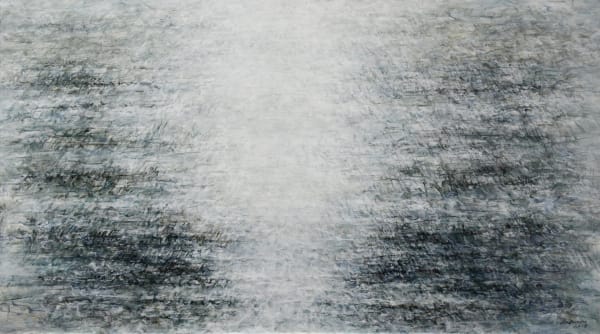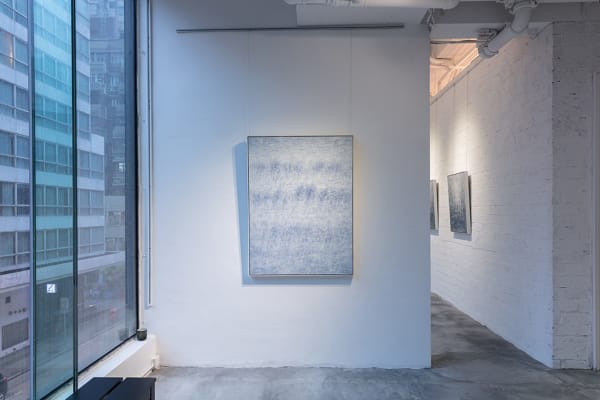Phantom Brushstrokes: Liu Guofu Solo Exhibition
All bets in modern painting have been placed on the leaving of enchanting, breathing brushstrokes. The brushstrokes of paintings are the beautiful gifts an artist leaves to the world. When we see the enchanting, intoxicating brushstrokes of Liu Guofu, we finally gain a true sense of the allure of Chinese painting.
Liu Guofu has continued in the great writing tradition of Chinese culture, from Ni Zan to Gong Xian, while engaging in a dialogue with the great Western masters of Abstract Painting, with the techniques of late Cézanne and Giacometti, forming his own techniques and syntax: distant, stacked traces of shadows, like smoke in jade: like the shadow traces of the phantom brush. Such poetic shadow traces are the remnant traces of existence, as well as the “phantom brushstrokes” of writing: they are like dreams and illusions, like smoke and jade. Each individual brushstroke appears useless, an absentminded flare, but in the end, they come together to create a poetic remnant image. This is the “phantom brush” Liu Guofu has invented. It forms the basic syntax of his painting. It represents an outstanding achievement in contemporary Chinese infra-mince art, and shows us the true modern qualities and international potential for a “Chinese-style painting.”
When we approach Liu Guofu’s artworks, whether it is the amazing Open Space series or the Pervading series, when our gaze falls on the brushstrokes in the paintings, we are drawn deeply within: fissures, shards of ice, fragments, non-action, destruction, devastation, fragility, thinness, it all stacks together to form a unique stacked brushwork that forms an aura-like thickness resembling a moss print or a trace of a shadow. It appears so light and diffuse like smoke, transparent and solid like jade. In these shadow traces of the phantom brush, air, light, water and qi proliferate throughout, dim shadows creating illusions of distancing, of searching in confusion, the secret anguish of disorientation and boundlessness.
Liu Guofu’s painting has changed our perspective of observation and our means of perception. Up close, we see that the brushstrokes are all chaotic, fragmented, disordered, restless, ruin-like, disoriented. From a distance, the brushstrokes accumulate to form an empty tranquility that is permeable, poetic, with the feel of jade, breathing in deep concentration. Such a paradoxical tension—a piercing, torn sense of pain and an empty, transparent feel of jade—is generated from a series of destruction and reconstruction, of repeated painting. These works allow us to see the unique contribution of the purely visual side of modern aesthetics. This is the aura of “reverse reconstruction.” It is generation in destruction.
These brushstrokes appear empty, but each stroke is actually firm, like blocks of ice, cold, fragile, fragmentary. This is conceptuality, a conceptuality richly imbued with a vital sense of touch that embodies the tactile nature of life. Or, perhaps it is like ruins, not graphic representation but dialectical brushwork, a deeper spiritual expression of the inner perceptions of life. The color of the paintings emerges as a dark blue, the most alluring hue in Chinese culture. It is the spiritual tone that lies between the fading of time and the yearning to hold on, between the scattering of the winds, and the odes that hold together, between the simplicity of the void and the beauty of transparency, between the pain of tragedy and the passions of courage. It is a Chinese color in the truest sense. It appears abstract and monochrome, but it harbors countless other tones within, all shrouded in this darkness, rich with enchanting poetry.
It is as Liu Guofu has said: “Each person’s brushstrokes are the traces they leave in the world. These are spiritual traces. It was so with the great Ni Zan.” Of course, it is the same spirit with Liu Guofu.
This is Liu Guofu’s first solo exhibition since his major breakthrough in infra-mince painting in 2012. His reverse reconstruction in “phantom brushstrokes” and “infra-chrome” transforms decay into legend, casts off the conventions of art history, dissolves the oil-based properties of paint with the water nature of ink, while finding the eternal generation of nature within dissolution and construction, fragmentation and coalescence, scattering and passage, light and qi. He brings together the two poetic textures of “crystal” and “flame.” This beautiful dark blue awakens the aura of nature. This is a work of art that can stand in the world for the infra-chrome aesthetics of Chinese art.
-
 Liu Guofu 劉國夫, Pervasion No. 12《彌漫 - 12》, 2016
Liu Guofu 劉國夫, Pervasion No. 12《彌漫 - 12》, 2016 -
 Liu Guofu 劉國夫, Pervasion No. 14《彌漫 - 14》, 2016
Liu Guofu 劉國夫, Pervasion No. 14《彌漫 - 14》, 2016 -
 Liu Guofu 劉國夫, Pervasion No. 16《彌漫 - 16》, 2016
Liu Guofu 劉國夫, Pervasion No. 16《彌漫 - 16》, 2016 -
 Liu Guofu 劉國夫, Pervasion No. 13《彌漫 - 13》, 2016
Liu Guofu 劉國夫, Pervasion No. 13《彌漫 - 13》, 2016 -
 Liu Guofu 劉國夫, Open Space No. 9《敞 - 9》, 2013
Liu Guofu 劉國夫, Open Space No. 9《敞 - 9》, 2013 -
 Liu Guofu 劉國夫, Open Space No. 16《敞 - 16》, 2013
Liu Guofu 劉國夫, Open Space No. 16《敞 - 16》, 2013 -
 Liu Guofu 劉國夫, Pervasion No. 21《彌漫 - 21》, 2016
Liu Guofu 劉國夫, Pervasion No. 21《彌漫 - 21》, 2016


















